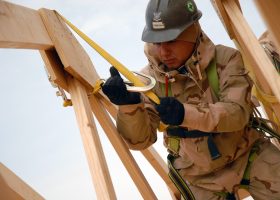Dropped Object Protection, Eliminating Risks with ANSI/ISEA 121-2018

On worksites across the nation it’s safe to say that to most construction workers, tool tethering means duct tape and twine. The launch of ANSI/ISEA 121-2018 not only defined dropped object prevention as a best practice, it defined exactly what prevention meant. Surprise: Duct tape and twine didn’t make the cut.
What is ANSI/ISEA 121-2018?
121-2018 was developed by the International Safety Equipment Association (ISEA) and quickly adopted by the American National Standards Institute (ANSI). ANSI/ISEA 121-2018 is a voluntary consensus standard which establishes the minimum design, performance, and labeling requirements for product solutions and guidelines for testing.
The standard focuses on four classes of preventive solutions actively used by workers to mitigate dropped objects:
- Anchor Attachments: Retrofit attachment points installed onto fixed anchor locations like structure or a worker themselves to anchor tool tethers.
- Tool Attachments: Retrofit attachment points installed onto tools and equipment, allowing them to be tethered.
- Tool Tethers: Lanyards that connect tools to an anchor point.
- Containers: Bags and buckets that are used to transport tools and equipment to and from at-height work zones.
This standard does not address passive preventive solutions such as netting, toe boards, etc.
Quick Refresher
Voluntary consensus standards for safety products are the formalization of requirements for equipment, giving manufacturers guidelines for designing and testing product. They are not directly enforceable by OSHA but may be cited under the General Duty Clause or through a Letter of Interpretation.
Though the latest 2017 statistics from the Bureau of Labor Statistics show a slight decline in reported injuries (45,940 vs. 47,920 in 2016) and fatalities (237 vs. 255 in 2016) due to workers being struck by falling or dropped objects, there’s still plenty of work to do in educating crews on eliminating the risk.
Blog Posts
Latest Posts
Related Posts




